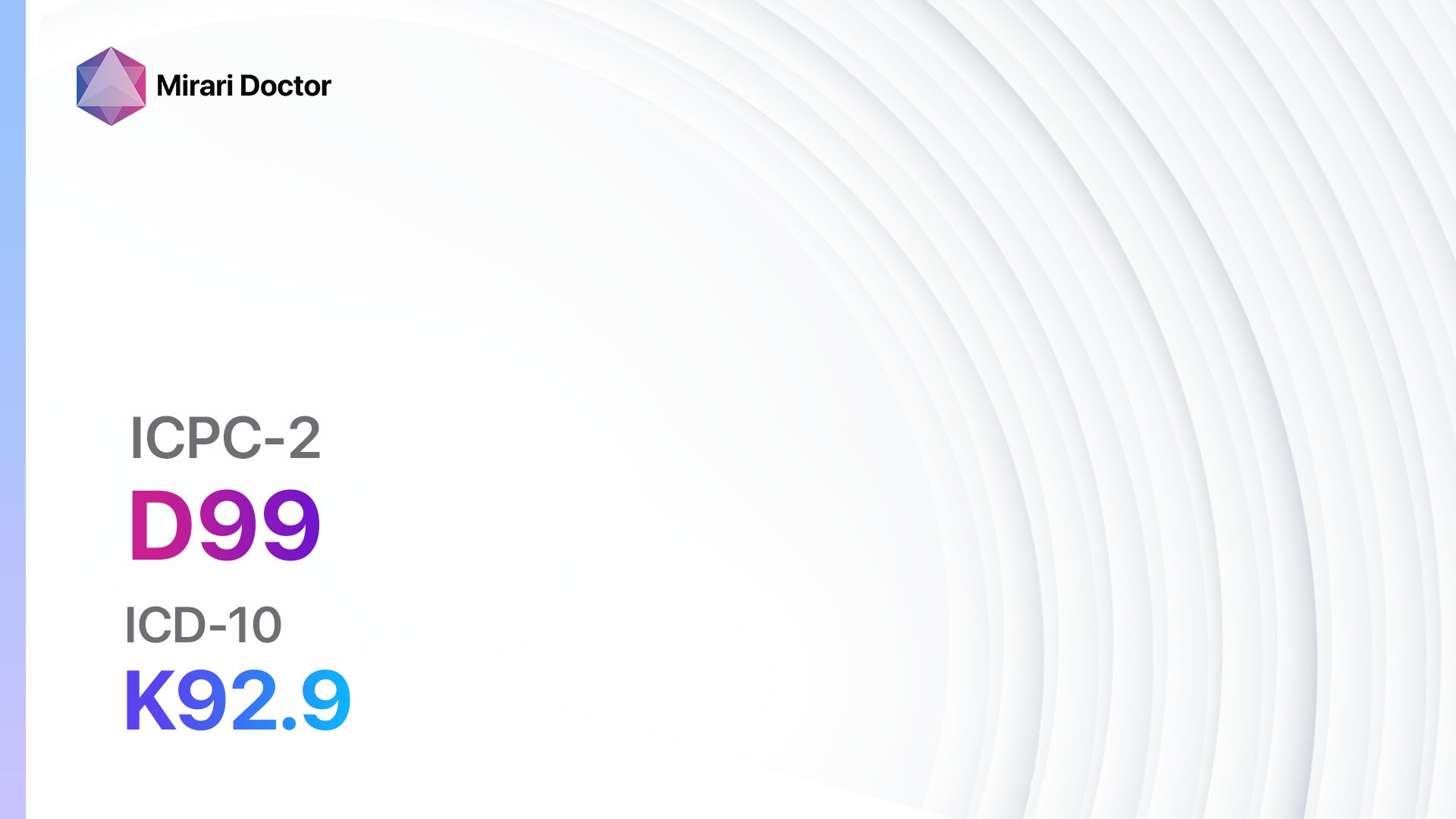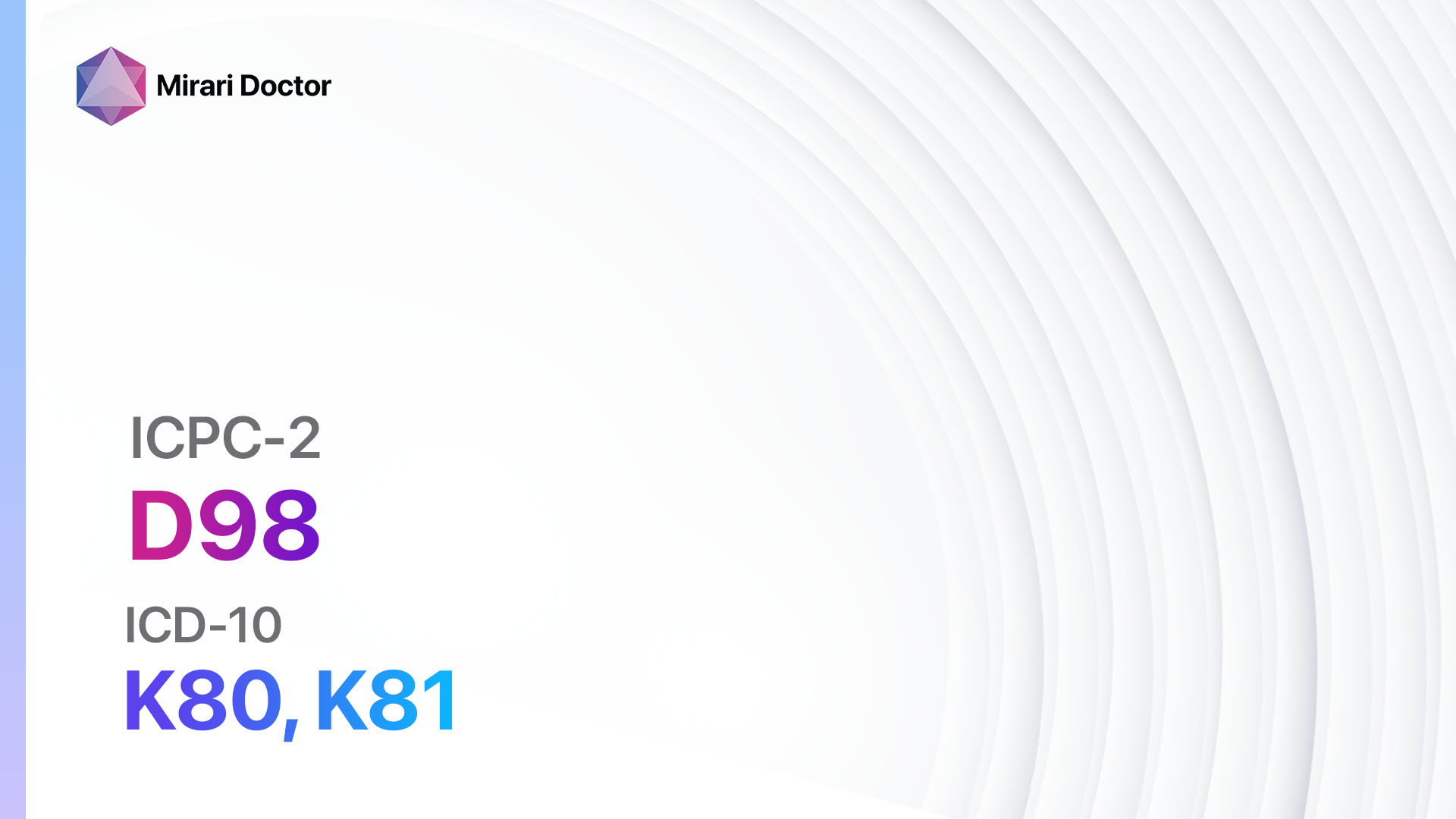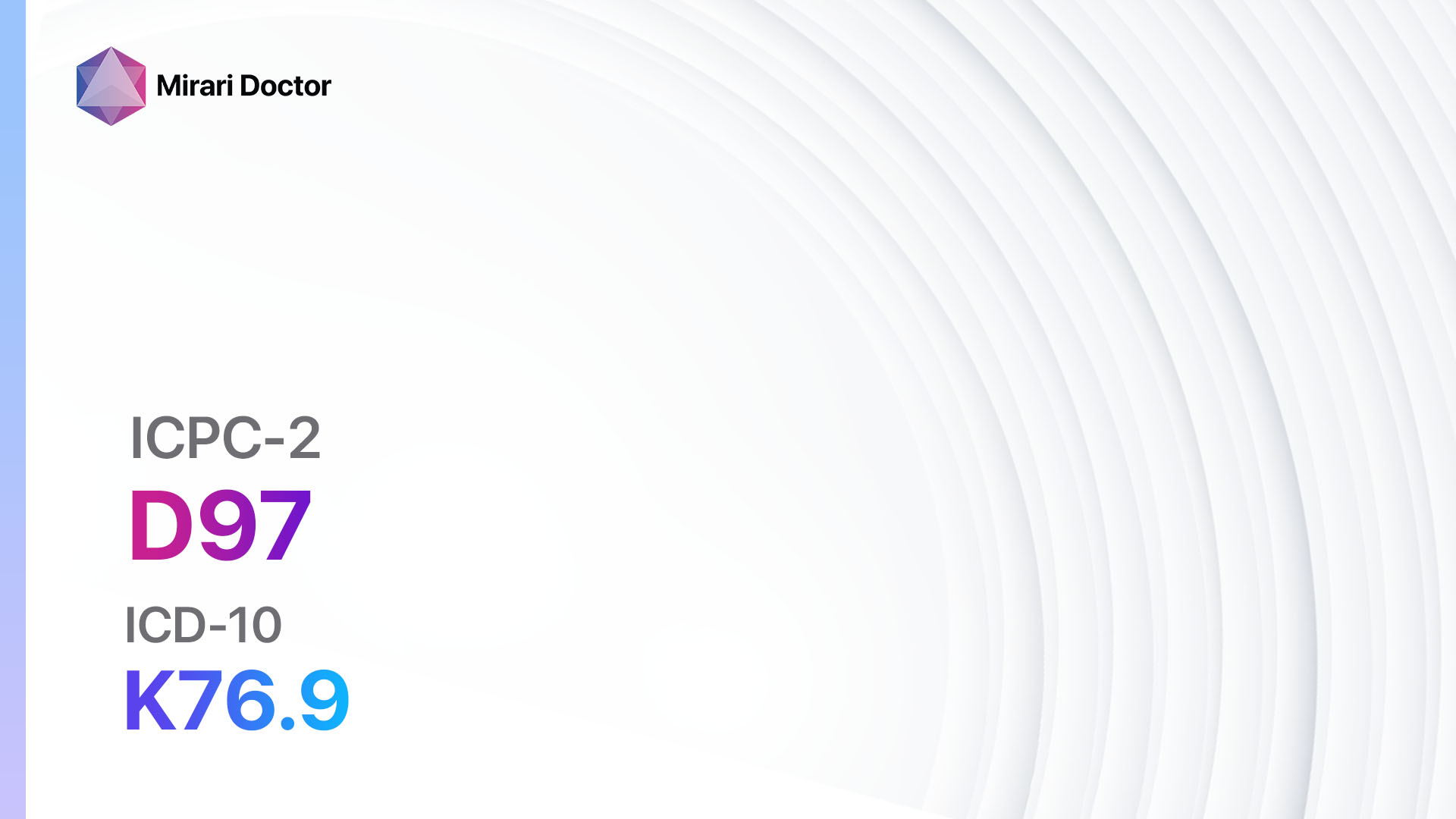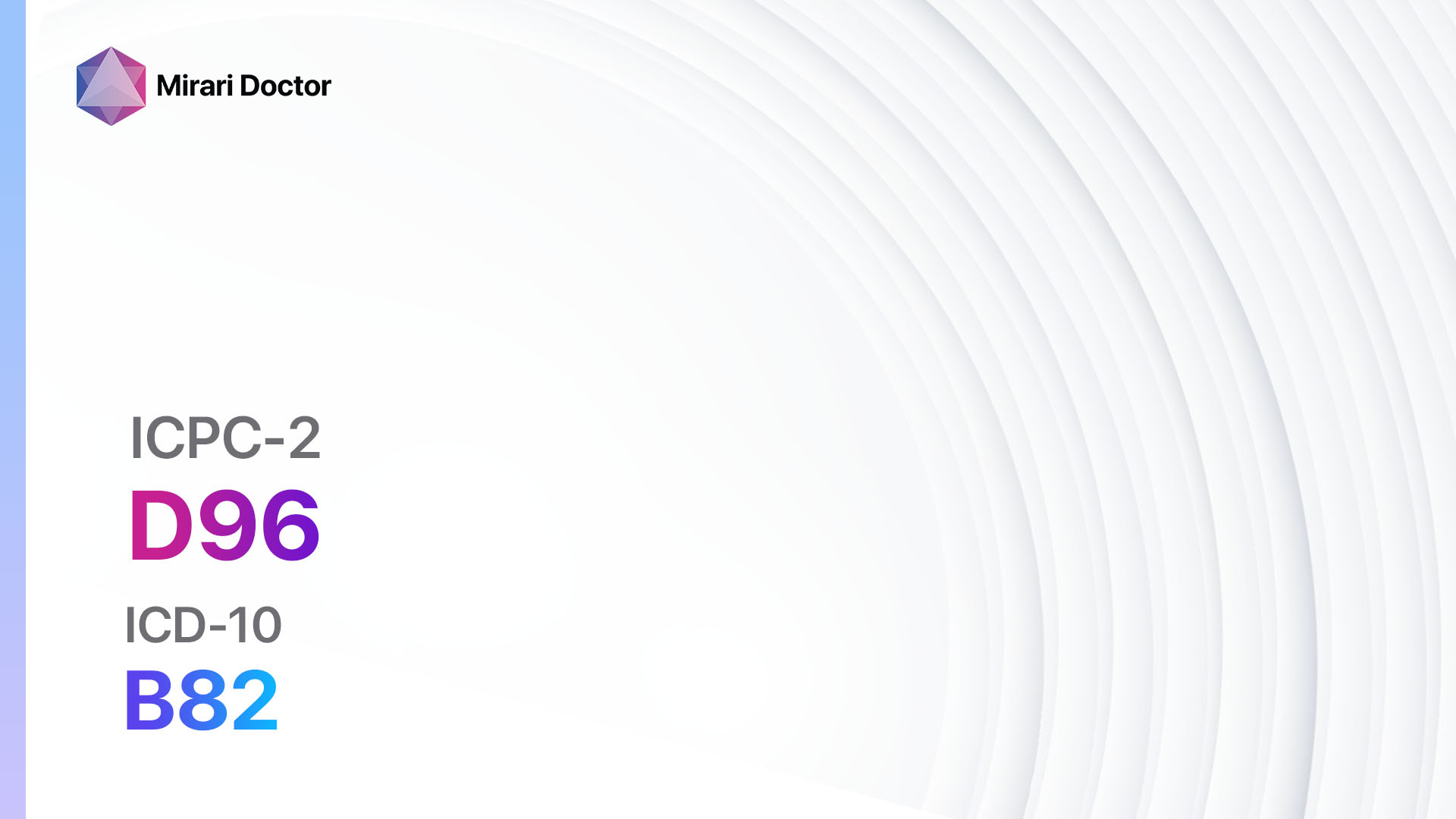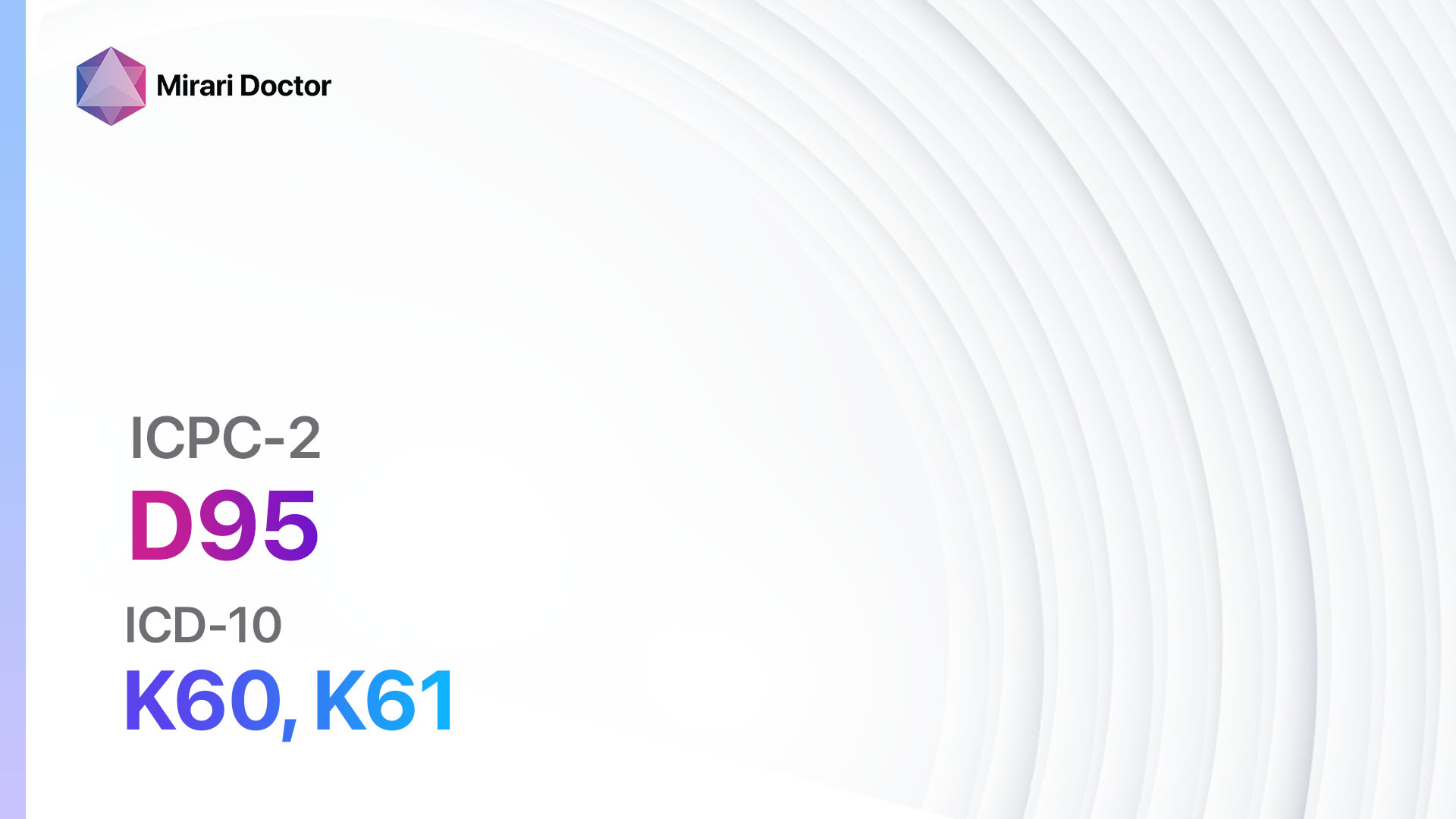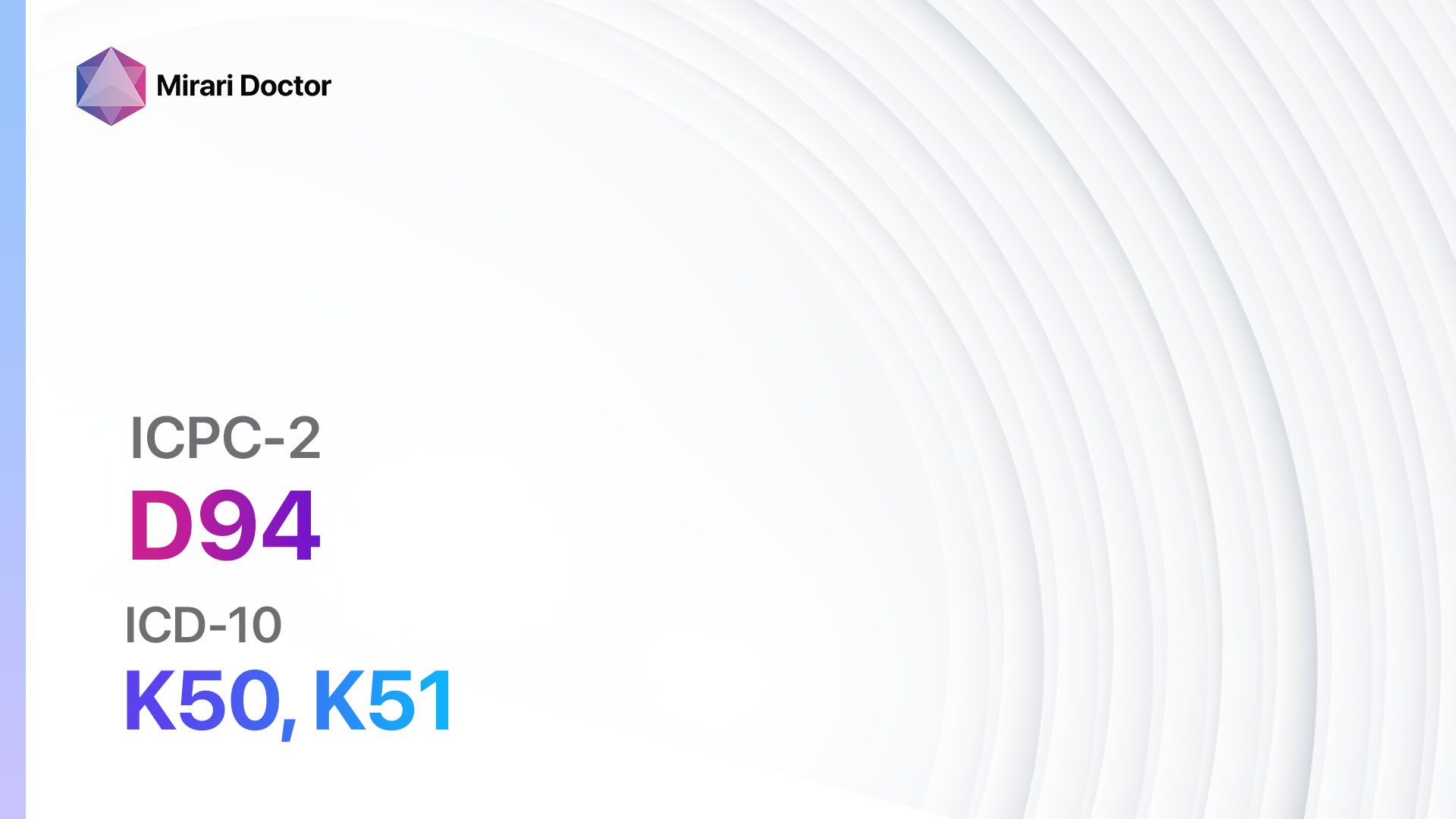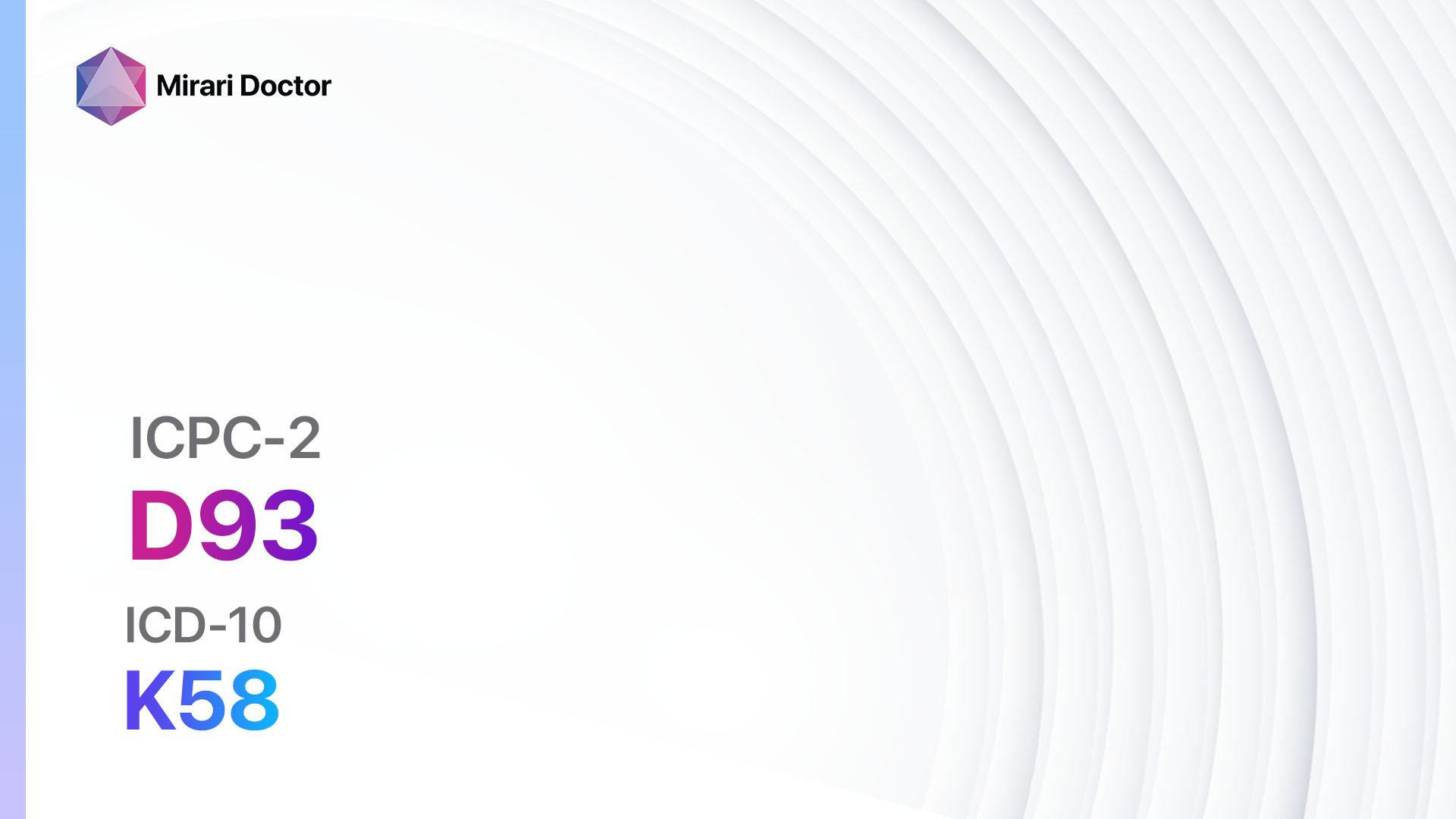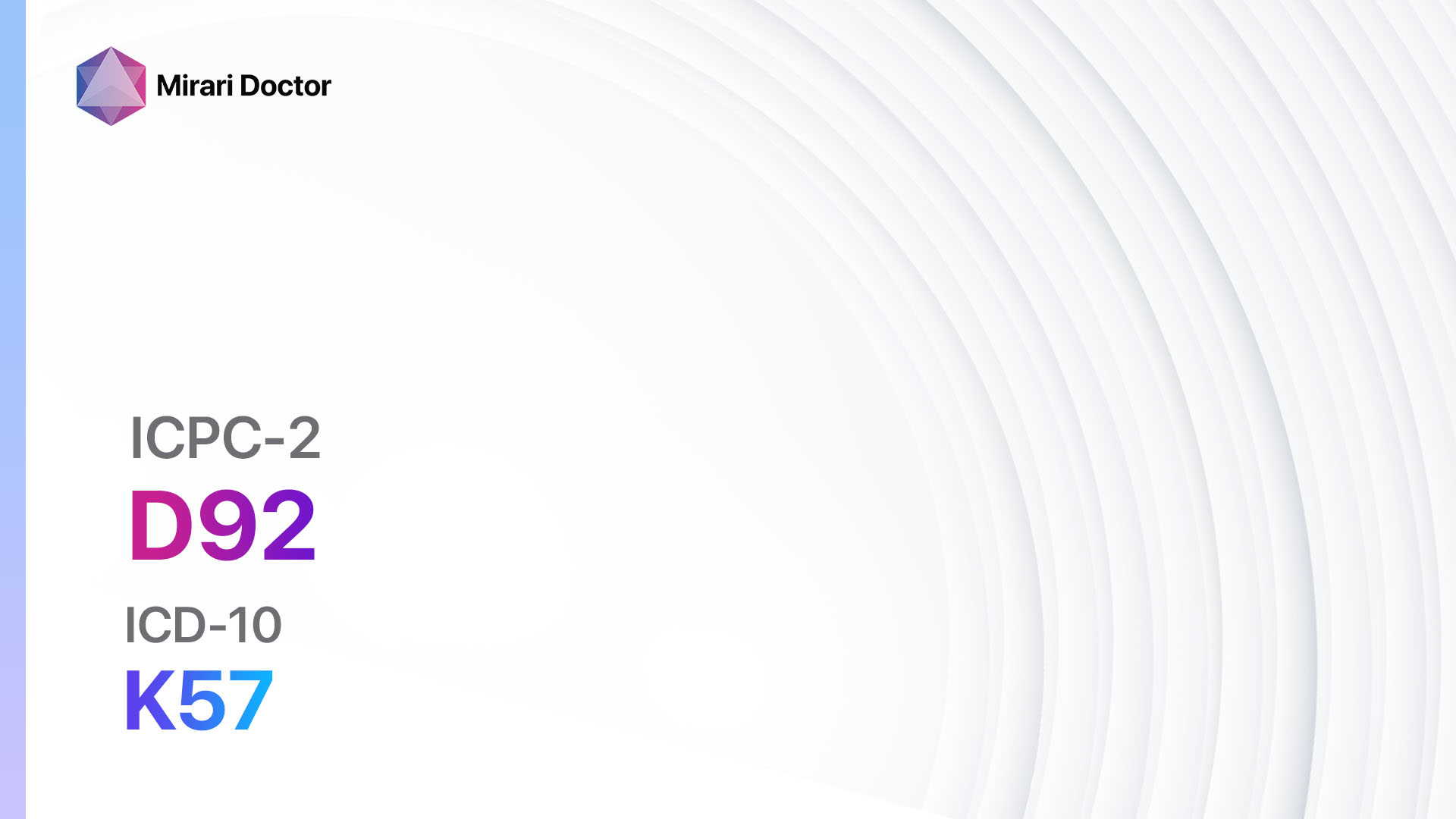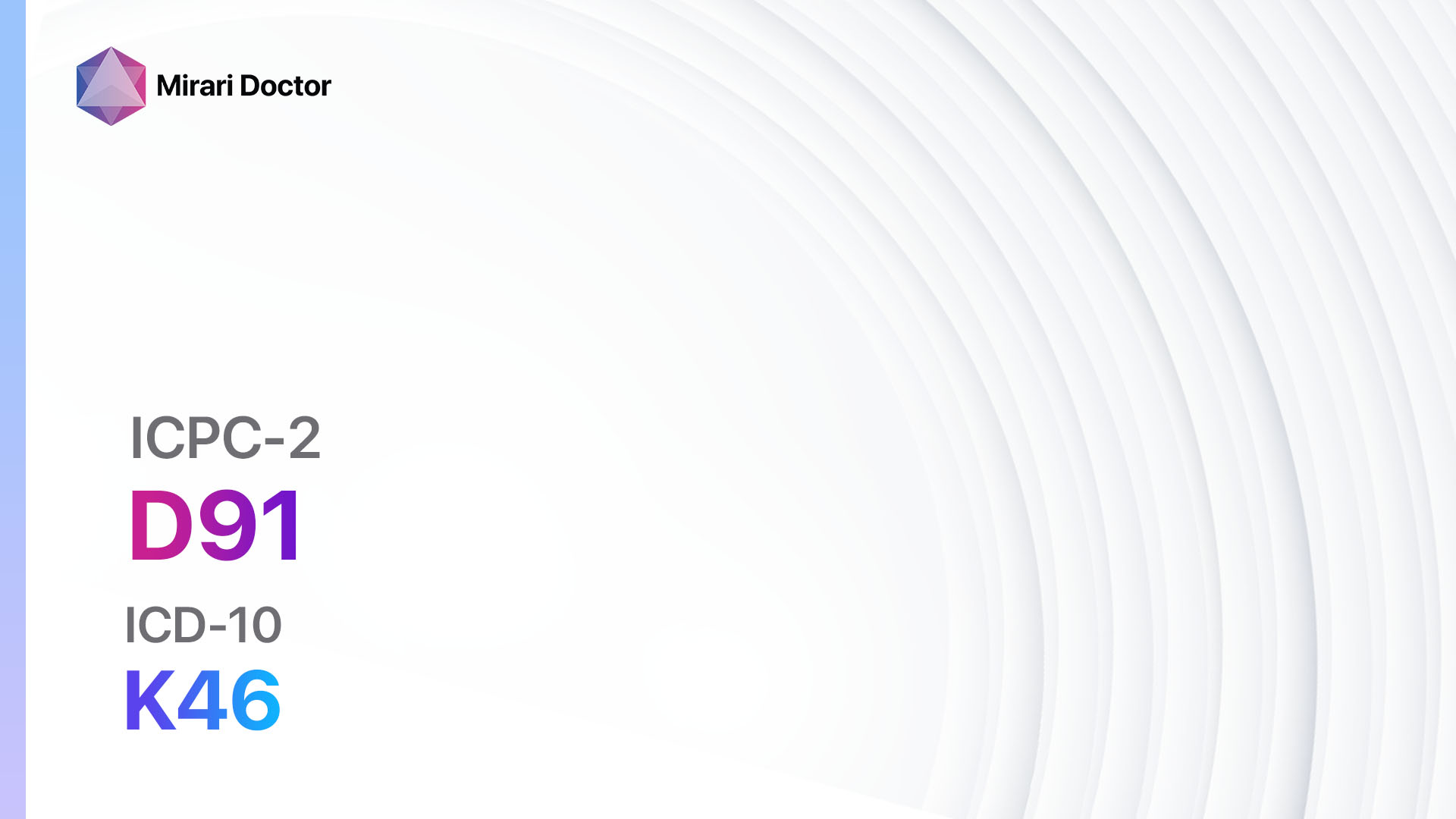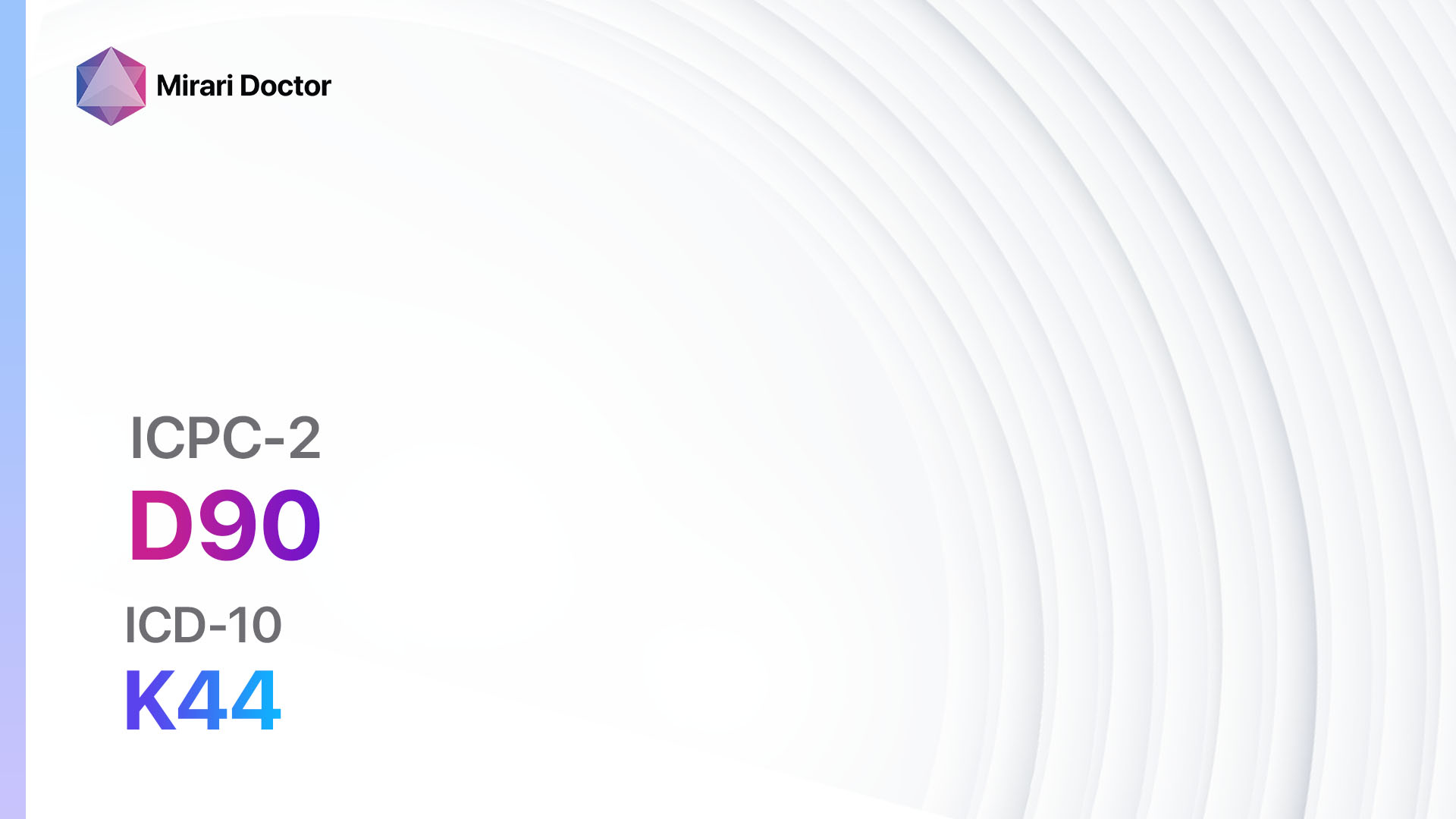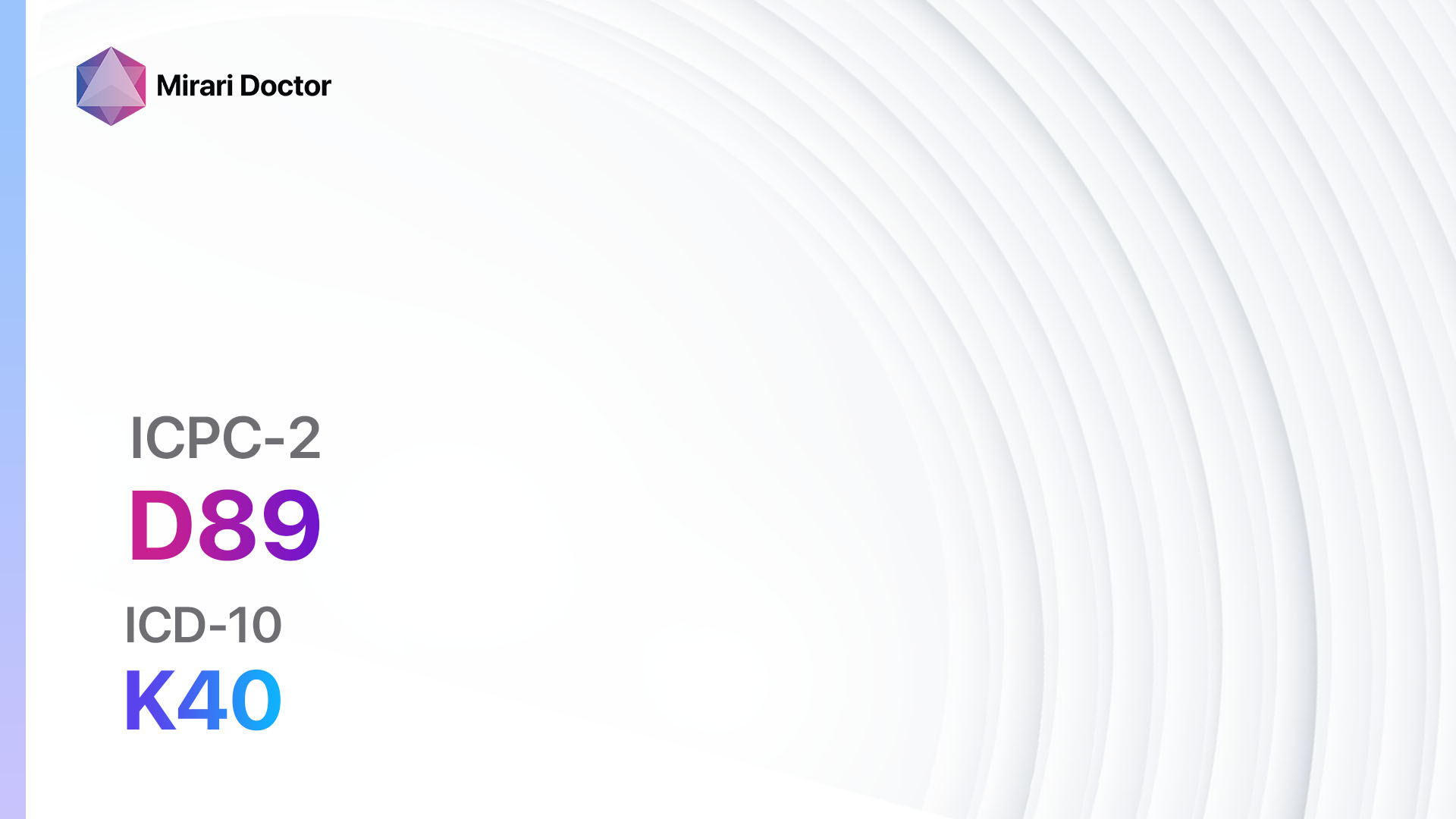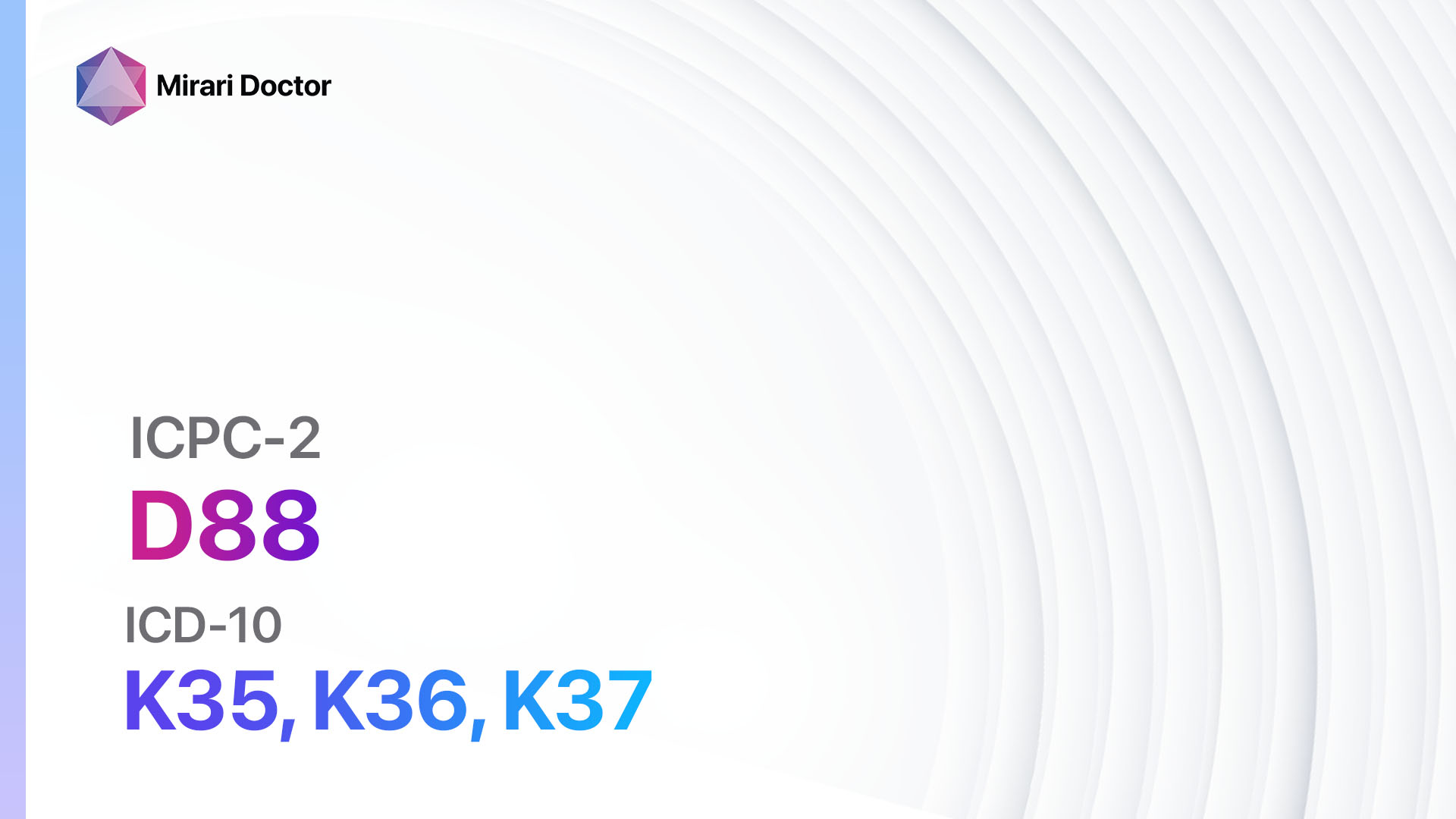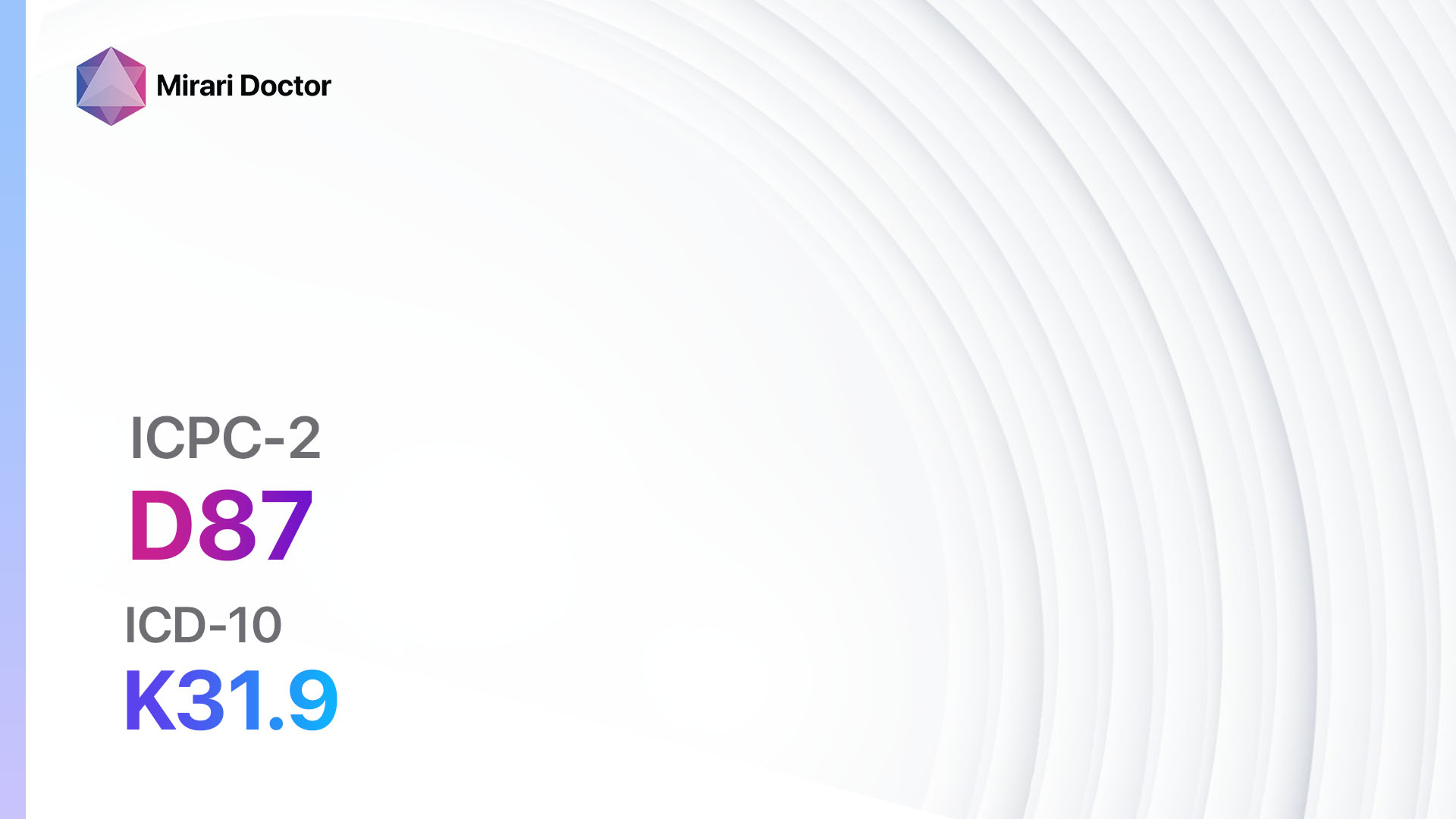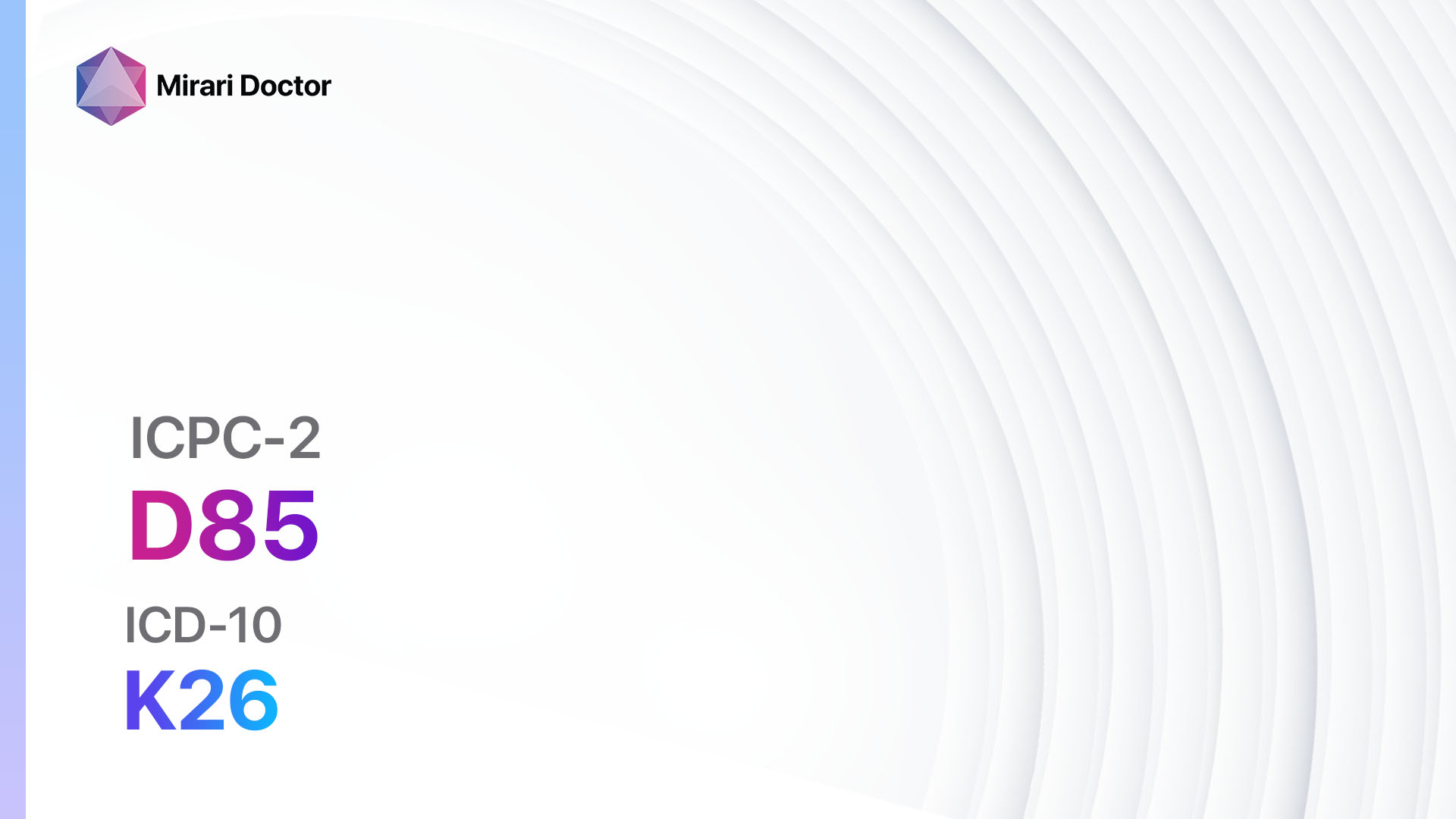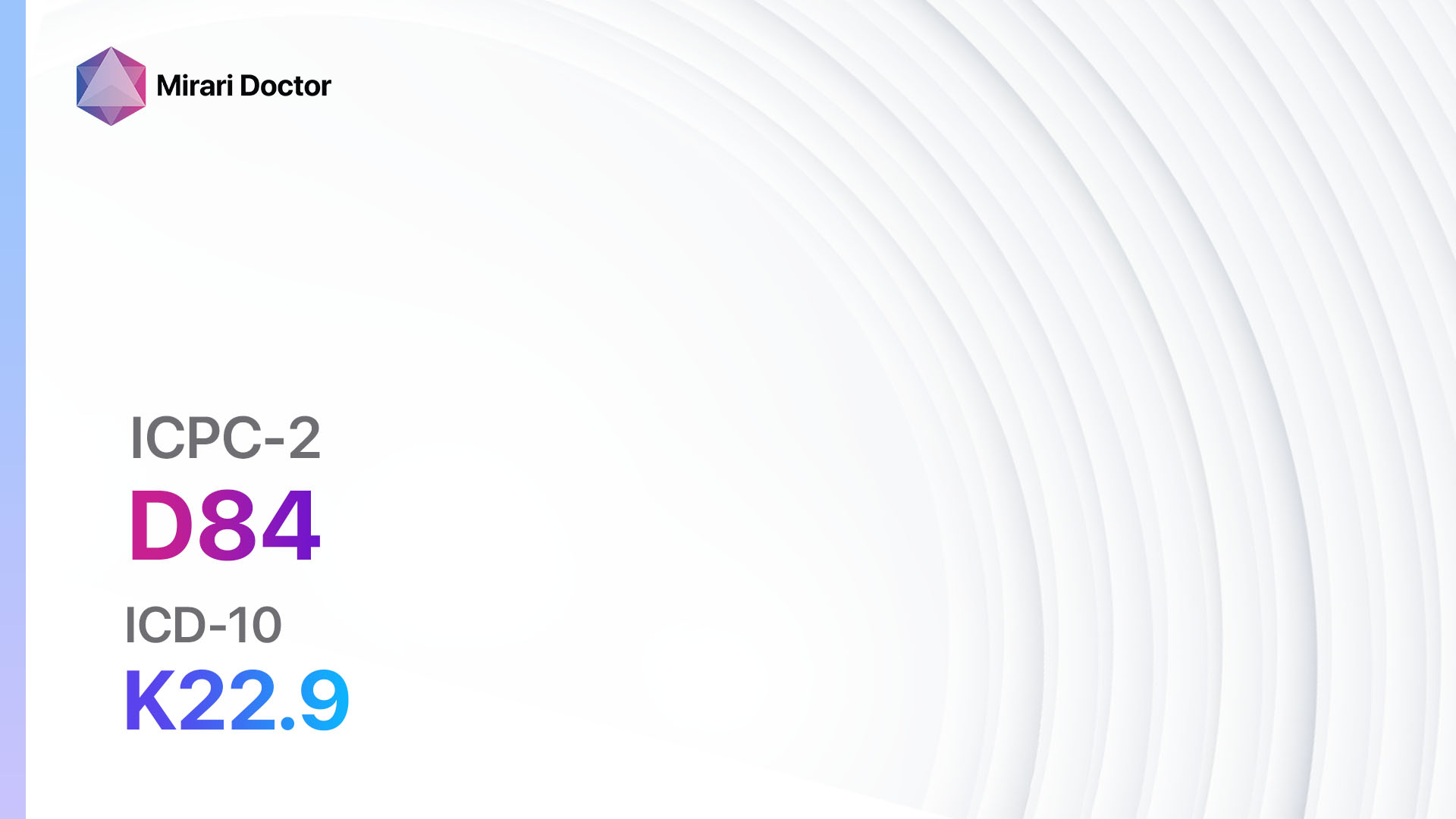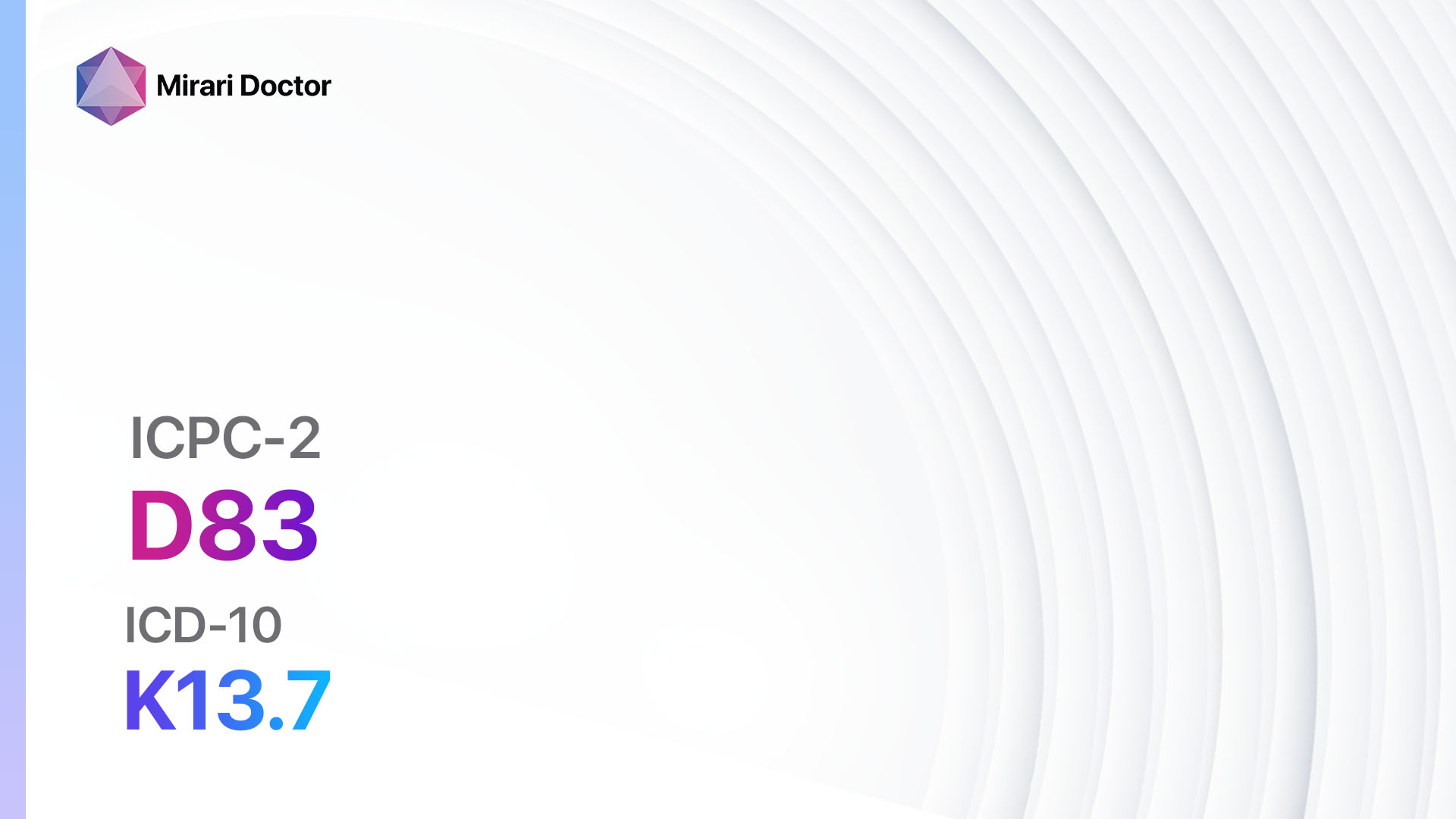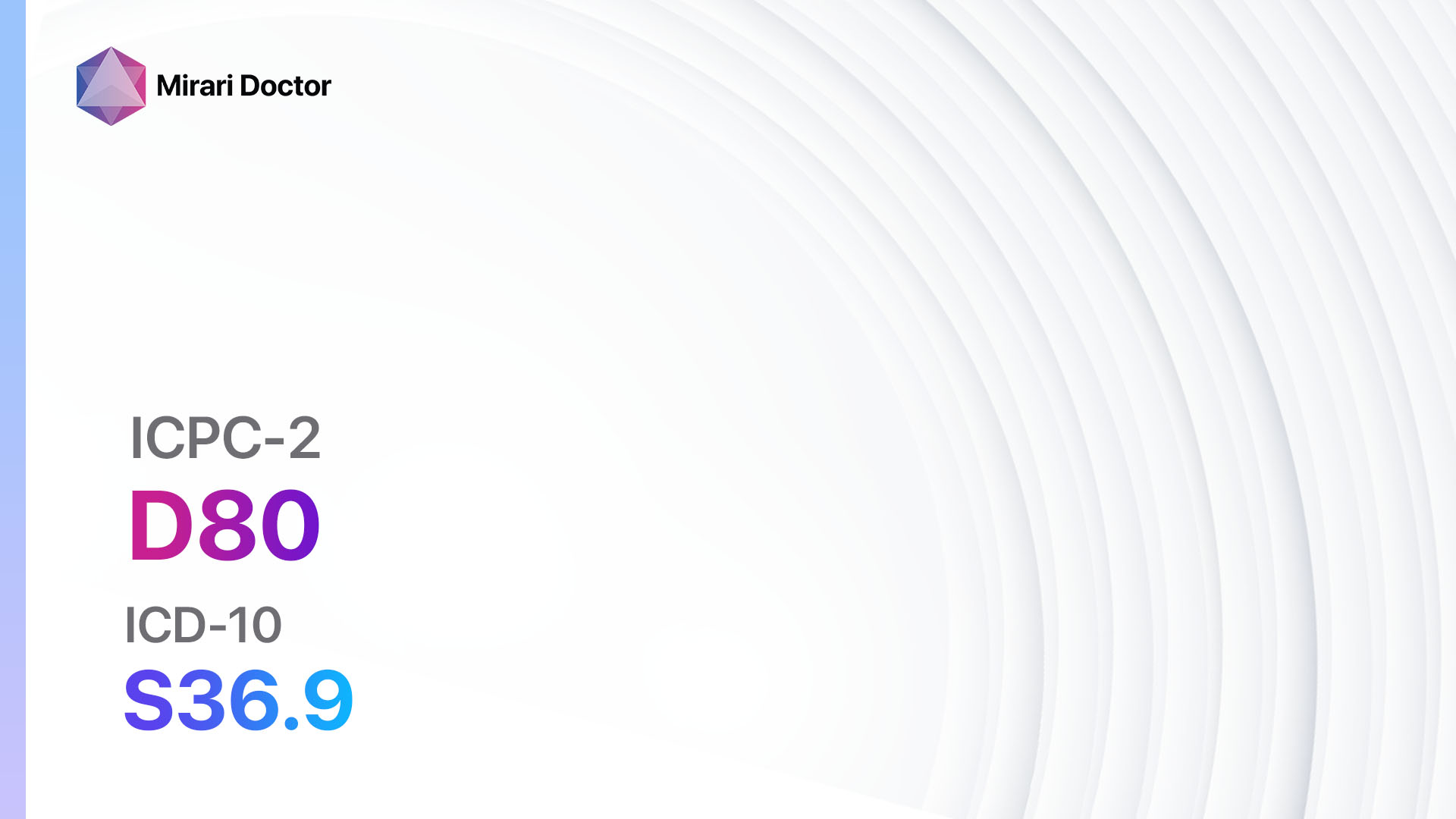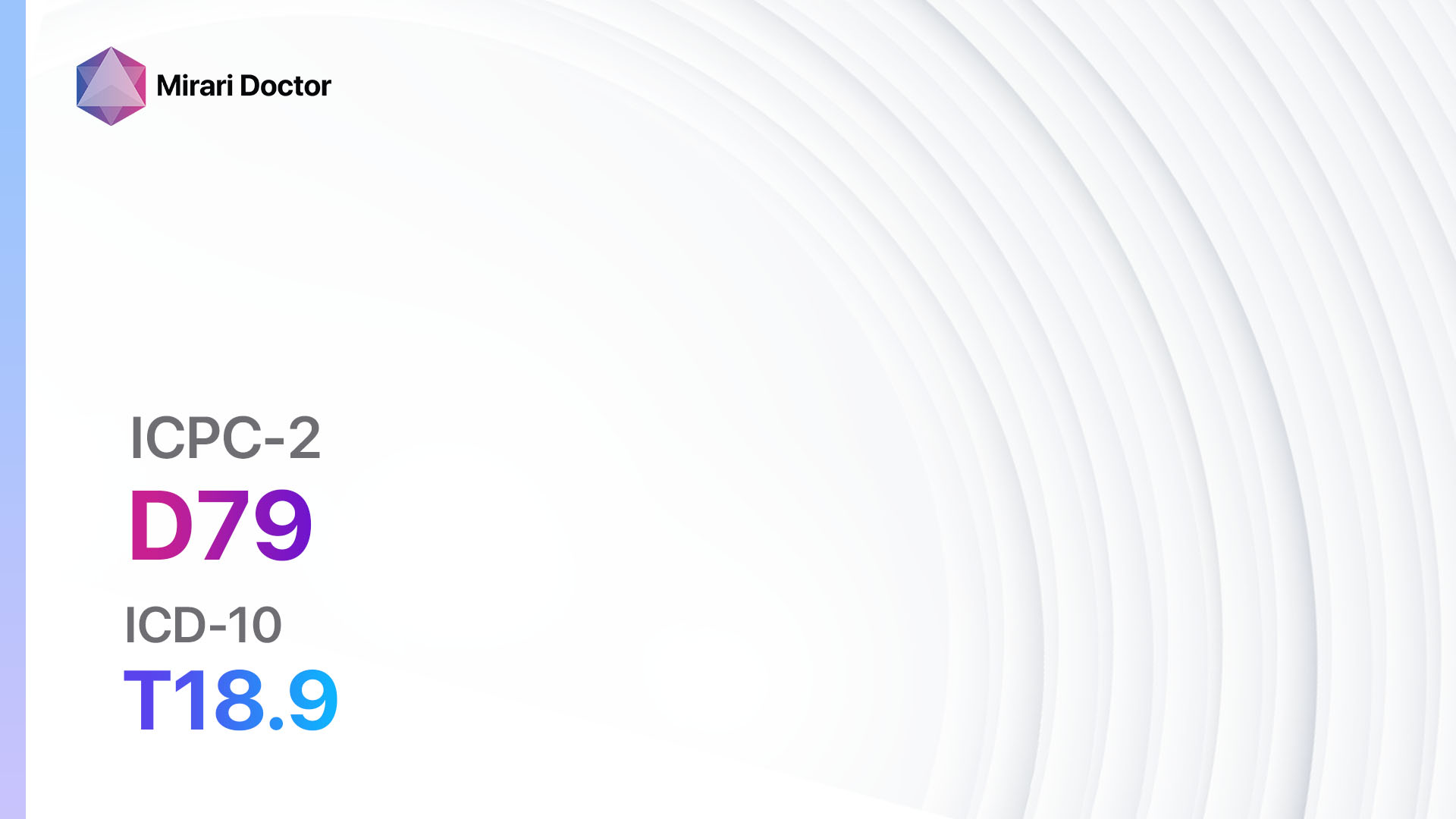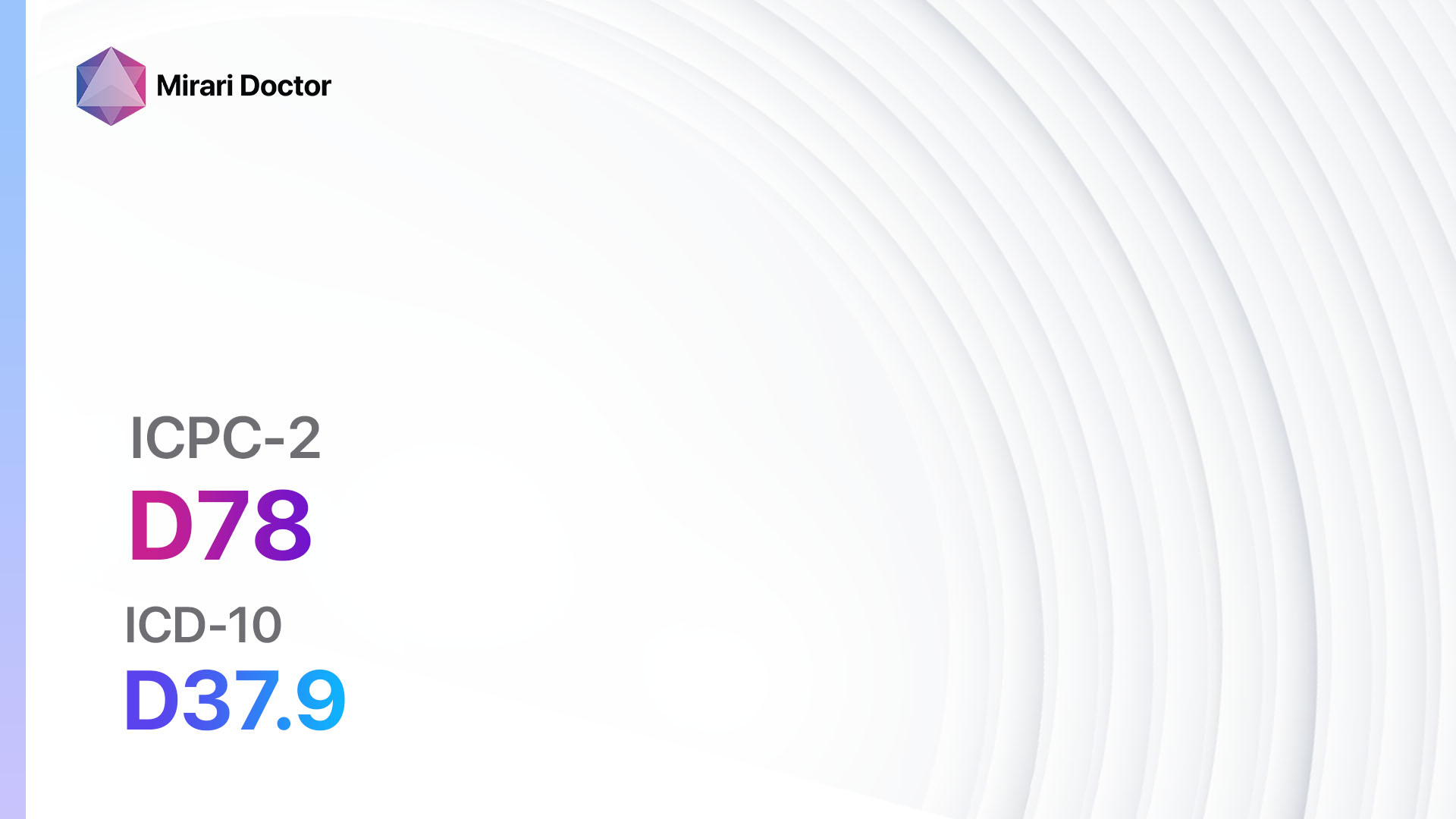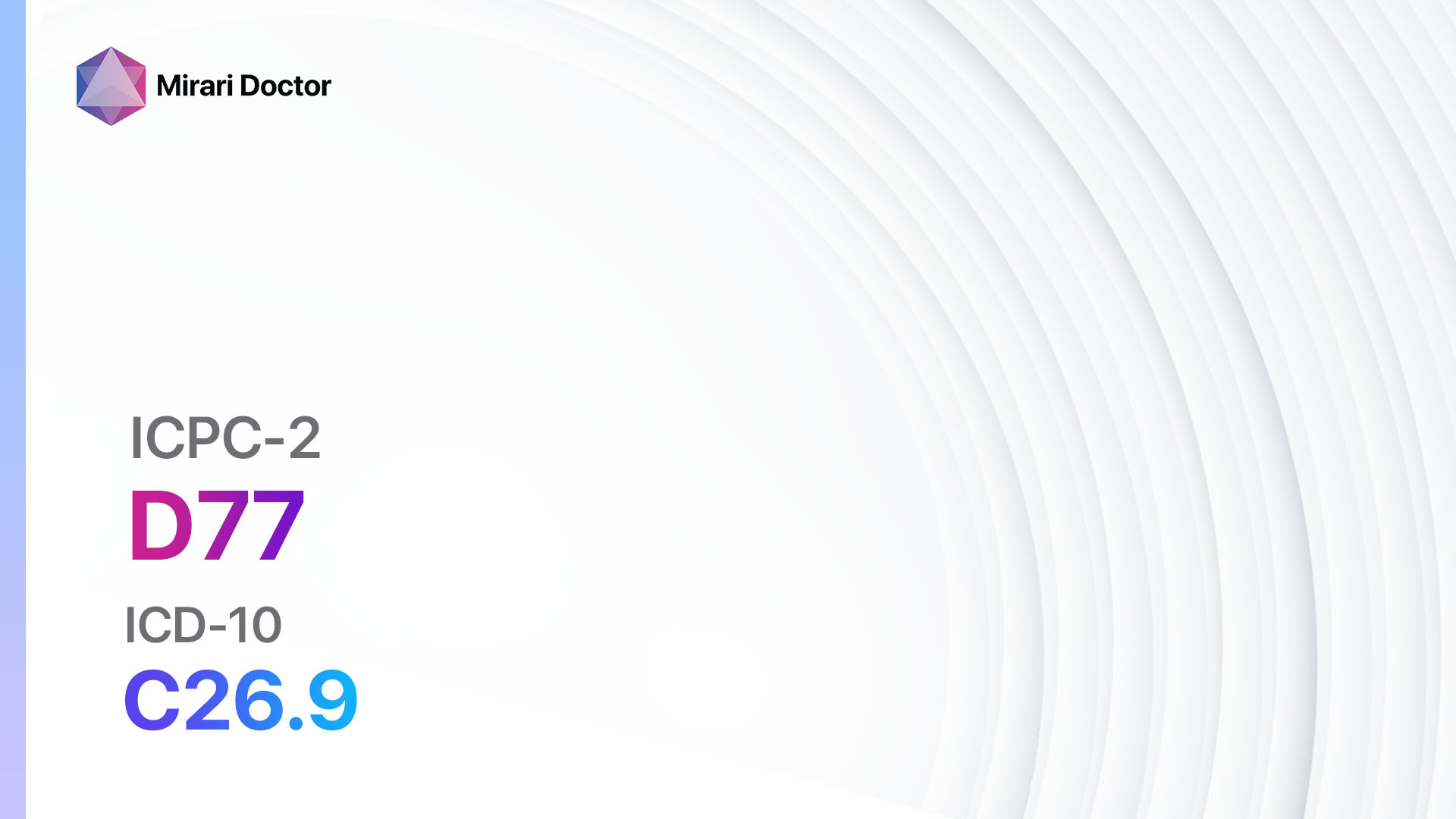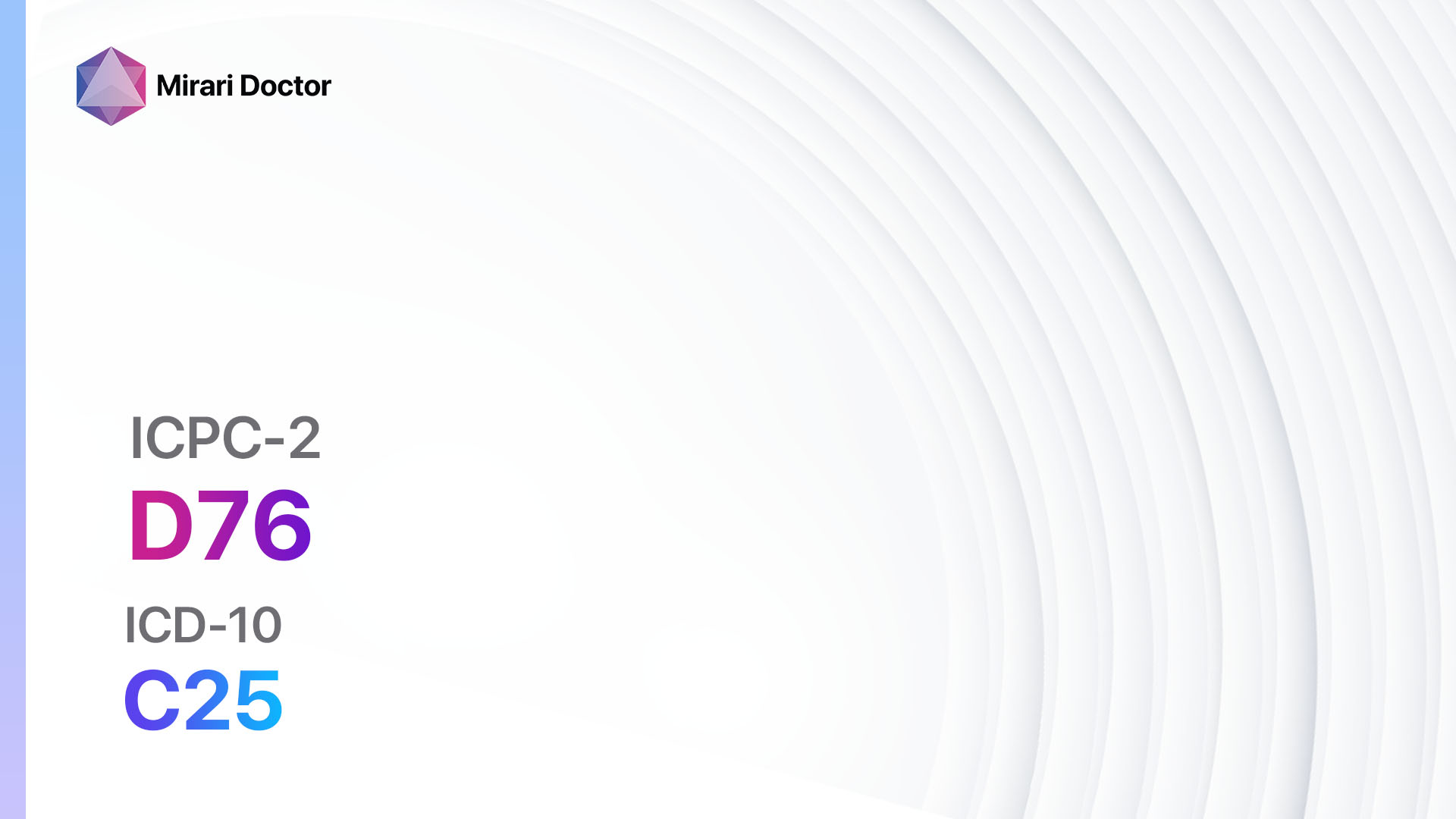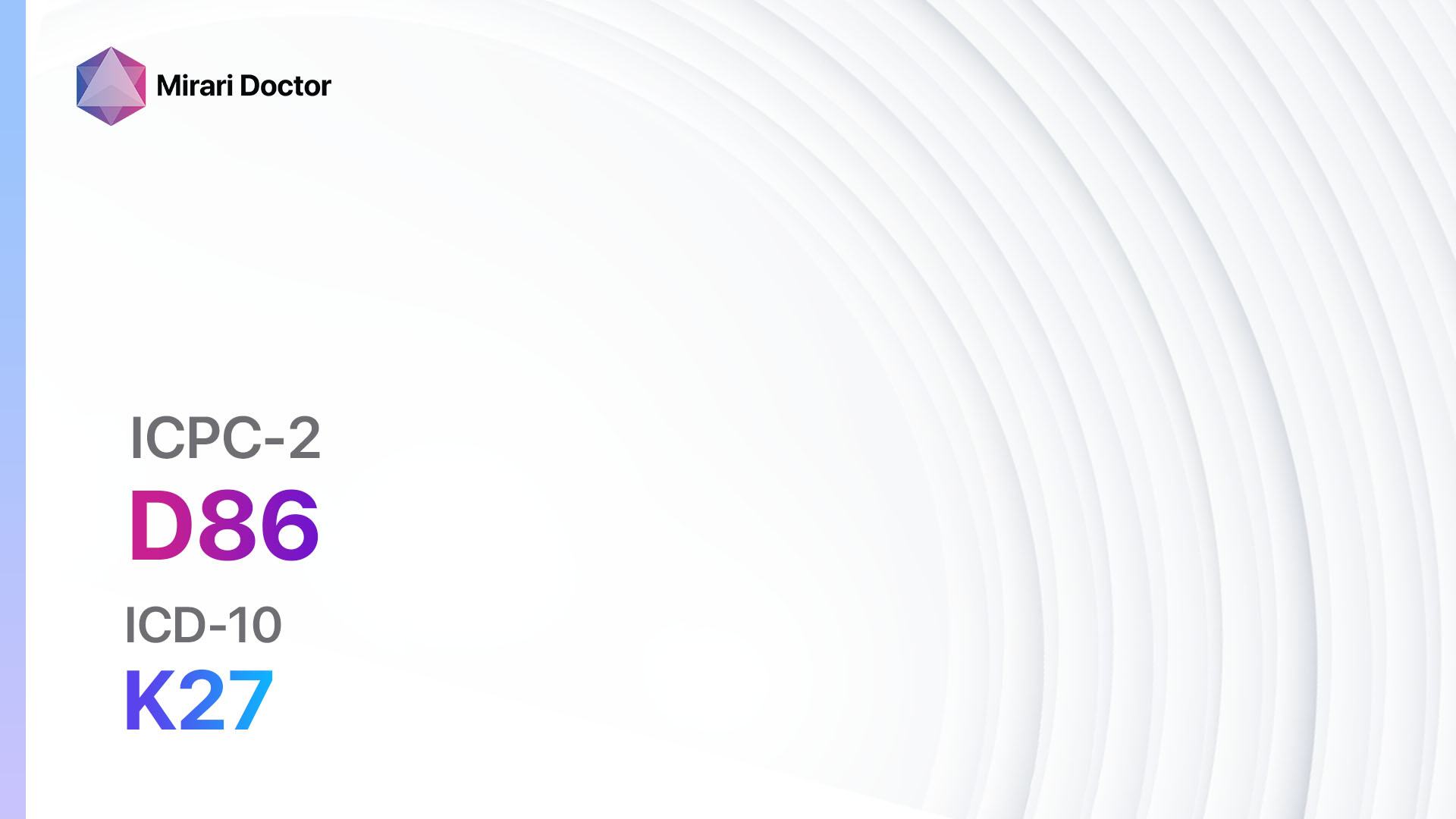
Introduction
Peptic ulcer is a condition characterized by open sores that develop on the lining of the stomach, upper small intestine, or esophagus. These ulcers can cause abdominal pain, bloating, and discomfort. Peptic ulcers are commonly caused by the bacteria Helicobacter pylori or the use of nonsteroidal anti-inflammatory drugs (NSAIDs)[1][2]. The aim of this guide is to provide a comprehensive overview of the symptoms, causes, diagnostic steps, possible interventions, and lifestyle interventions for peptic ulcer other (ICPC-2: D86).
Codes
- ICPC-2 Code: D86 Peptic ulcer other
- ICD-10 Code: K27 Peptic ulcer, site unspecified
Symptoms
- Abdominal pain: A burning or gnawing pain in the abdomen, typically between the breastbone and the navel[3].
- Bloating: Feeling of fullness or discomfort in the abdomen[4].
- Nausea and vomiting: Feeling sick to the stomach and vomiting[5].
- Loss of appetite: Decreased desire to eat[6].
- Weight loss: Unintentional weight loss due to reduced appetite[7].
- Dark or black stools: Stools that are dark or black in color, indicating the presence of blood[8].
- Fatigue: Feeling tired or weak[9].
Causes
- Helicobacter pylori infection: This bacteria can damage the protective lining of the stomach and small intestine, leading to the formation of ulcers[1].
- Nonsteroidal anti-inflammatory drugs (NSAIDs): Regular use of NSAIDs, such as aspirin or ibuprofen, can irritate the stomach lining and increase the risk of developing ulcers[2].
Diagnostic Steps
Medical History
- Gather information about the patient’s symptoms, including the duration and severity of abdominal pain, bloating, and other associated symptoms.
- Inquire about the use of NSAIDs or any history of H. pylori infection.
- Assess the patient’s medical history for any underlying conditions that may contribute to the development of peptic ulcers, such as liver disease or kidney disease.
Physical Examination
- Perform a thorough physical examination, focusing on the abdomen to assess for tenderness or swelling.
- Check for signs of anemia, such as pale skin or fatigue.
- Look for any signs of weight loss or nutritional deficiencies.
Laboratory Tests
- pylori testing: This may include a blood test, stool test, or breath test to detect the presence of H. pylori bacteria[10].
- Complete blood count (CBC): To check for anemia or signs of infection.
- Liver function tests: To assess liver health and rule out any underlying liver disease.
- Kidney function tests: To evaluate kidney function and rule out any underlying kidney disease.
Diagnostic Imaging
- Upper endoscopy: A thin, flexible tube with a camera is inserted through the mouth to visualize the esophagus, stomach, and small intestine. This allows for direct visualization of any ulcers or inflammation.
- Upper gastrointestinal series: X-rays are taken after the patient drinks a contrast material to highlight the digestive tract. This can help identify any abnormalities or ulcers.
Other Tests
- Biopsy: During an upper endoscopy, a small tissue sample may be taken for further analysis to confirm the presence of H. pylori or rule out other conditions.
- Gastric acid analysis: This test measures the amount of acid in the stomach to assess for excessive acid production.
Follow-up and Patient Education
- Schedule follow-up appointments to monitor the patient’s response to treatment and ensure proper healing of the ulcers.
- Provide education on lifestyle modifications and medication adherence to prevent recurrence of peptic ulcers.
Possible Interventions
Traditional Interventions
Medications:
Top 5 drugs for Peptic ulcer other (ICPC-2: D86):
- Proton pump inhibitors (PPIs) (e.g., Omeprazole, Esomeprazole):
- Cost: Generic versions can be $10-$50/month.
- Contraindications: Hypersensitivity to PPIs.
- Side effects: Headache, diarrhea, abdominal pain.
- Severe side effects: Increased risk of fractures, Clostridium difficile infection.
- Drug interactions: Clopidogrel, warfarin, methotrexate.
- Warning: Long-term use may increase the risk of certain nutrient deficiencies.
- H2 receptor blockers (e.g., Ranitidine, Famotidine):
- Cost: Generic versions can be $10-$30/month.
- Contraindications: Hypersensitivity to H2 receptor blockers.
- Side effects: Headache, dizziness, constipation.
- Severe side effects: Rare, but may include blood disorders or liver problems.
- Drug interactions: Antacids, ketoconazole, atazanavir.
- Warning: May reduce the absorption of certain medications.
- Antacids (e.g., Aluminum hydroxide, Magnesium hydroxide):
- Cost: Over-the-counter options are available for <$10/month.
- Contraindications: Hypersensitivity to antacids.
- Side effects: Constipation or diarrhea, depending on the type.
- Severe side effects: Rare, but may include electrolyte imbalances.
- Drug interactions: May interfere with the absorption of other medications.
- Warning: Long-term use may lead to kidney problems.
- Antibiotics (e.g., Amoxicillin, Clarithromycin):
- Cost: Generic versions can be $10-$50/month.
- Contraindications: Hypersensitivity to antibiotics.
- Side effects: Nausea, diarrhea, stomach pain.
- Severe side effects: Rare, but may include severe allergic reactions.
- Drug interactions: Warfarin, methotrexate, theophylline.
- Warning: Complete the full course of antibiotics as prescribed.
- Bismuth subsalicylate:
- Cost: Over-the-counter options are available for <$10/month.
- Contraindications: Hypersensitivity to bismuth subsalicylate.
- Side effects: Darkening of the tongue or stool, constipation.
- Severe side effects: Rare, but may include Reye’s syndrome.
- Drug interactions: May interact with certain antibiotics.
- Warning: Not recommended for children or teenagers recovering from a viral infection.
Alternative Drugs:
- Sucralfate: Forms a protective coating over ulcers to promote healing.
- Misoprostol: Helps protect the stomach lining and reduce the risk of ulcers in patients taking NSAIDs.
- Metronidazole: An antibiotic that may be used in combination with other medications to treat H. pylori infection.
- Tetracycline: Another antibiotic that may be used in combination with other medications to treat H. pylori infection.
- Ranitidine bismuth citrate: Combines an H2 receptor blocker with bismuth to treat H. pylori infection.
Surgical Procedures:
- Endoscopic therapy: Involves using an endoscope to directly treat the ulcer by injecting medication, applying heat, or placing clips to stop bleeding.
- Surgical repair: In rare cases, surgery may be necessary to repair a perforated or bleeding ulcer.
Alternative Interventions
- Probiotics: May help restore the balance of bacteria in the digestive tract. Cost: $10-$50/month.
- Herbal remedies: Certain herbs, such as licorice root or chamomile, may have anti-inflammatory properties that can help with ulcer healing. Cost: Varies depending on the specific herb and form (tea, capsules, etc.).
- Acupuncture: May help reduce pain and promote relaxation. Cost: $60-$120 per session.
- Stress management techniques: Stress can worsen ulcer symptoms, so techniques such as meditation, yoga, or deep breathing exercises may be beneficial. Cost: Varies depending on the specific technique (free to the cost of classes or sessions).
- Dietary modifications: Avoiding spicy foods, alcohol, and caffeine, and incorporating more fruits, vegetables, and whole grains into the diet may help reduce ulcer symptoms. Cost: Varies depending on individual food choices.
Lifestyle Interventions
- Quit smoking: Smoking can increase stomach acid production and delay ulcer healing. Cost: Varies depending on the method used for smoking cessation.
- Limit alcohol consumption: Alcohol can irritate the stomach lining and increase the risk of ulcers. Cost: Varies depending on individual alcohol consumption habits.
- Manage stress: Stress can worsen ulcer symptoms, so finding healthy ways to manage stress, such as exercise or relaxation techniques, may be beneficial. Cost: Varies depending on the chosen stress management techniques.
- Maintain a healthy weight: Excess weight can increase the risk of developing ulcers and delay healing. Cost: Varies depending on individual weight management strategies.
- Follow a balanced diet: Eating a diet rich in fruits, vegetables, whole grains, and lean proteins can promote ulcer healing. Cost: Varies depending on individual food choices.
It is important to note that the cost ranges provided are approximate and may vary depending on the location and availability of the interventions.
Mirari Cold Plasma Alternative Intervention
Understanding Mirari Cold Plasma
- Safe and Non-Invasive Treatment: Mirari Cold Plasma is a safe and non-invasive treatment option for various skin conditions. It does not require incisions, minimizing the risk of scarring, bleeding, or tissue damage.
- Efficient Extraction of Foreign Bodies: Mirari Cold Plasma facilitates the removal of foreign bodies from the skin by degrading and dissociating organic matter, allowing easier access and extraction.
- Pain Reduction and Comfort: Mirari Cold Plasma has a local analgesic effect, providing pain relief during the treatment, making it more comfortable for the patient.
- Reduced Risk of Infection: Mirari Cold Plasma has antimicrobial properties, effectively killing bacteria and reducing the risk of infection.
- Accelerated Healing and Minimal Scarring: Mirari Cold Plasma stimulates wound healing and tissue regeneration, reducing healing time and minimizing the formation of scars.
Mirari Cold Plasma Prescription
Video instructions for using Mirari Cold Plasma Device – D86 Peptic ulcer other (ICD-10:K27)
| Mild | Moderate | Severe |
| Mode setting: 1 (Infection) Location: 3 (Kidney, Liver & Spleen) Morning: 15 minutes, Evening: 15 minutes |
Mode setting: 1 (Infection) Location: 3 (Kidney, Liver & Spleen) Morning: 30 minutes, Lunch: 30 minutes, Evening: 30 minutes |
Mode setting: 1 (Infection) Location: 3 (Kidney, Liver & Spleen) Morning: 30 minutes, Lunch: 30 minutes, Evening: 30 minutes |
| Mode setting: 2 (Wound Healing) Location: 3 (Kidney, Liver & Spleen) Morning: 15 minutes, Evening: 15 minutes |
Mode setting: 2 (Wound Healing) Location: 3 (Kidney, Liver & Spleen) Morning: 30 minutes, Lunch: 30 minutes, Evening: 30 minutes |
Mode setting: 2 (Wound Healing) Location: 3 (Kidney, Liver & Spleen) Morning: 30 minutes, Lunch: 30 minutes, Evening: 30 minutes |
| Mode setting: 3 (Antiviral Therapy) Location: 6 (Liver/Kidney Therapy) Morning: 15 minutes, Evening: 15 minutes |
Mode setting: 3 (Antiviral Therapy) Location: 6 (Liver/Kidney Therapy) Morning: 30 minutes, Lunch: 30 minutes, Evening: 30 minutes |
Mode setting: 3 (Antiviral Therapy) Location: 6 (Liver/Kidney Therapy) Morning: 30 minutes, Lunch: 30 minutes, Evening: 30 minutes |
| Mode setting: 7 (Immunotherapy) Location: 1 (Sacrum) Morning: 15 minutes, Evening: 15 minutes |
Mode setting: 7 (Immunotherapy) Location: 1 (Sacrum) Morning: 30 minutes, Lunch: 30 minutes, Evening: 30 minutes |
Mode setting: 7 (Immunotherapy) Location: 1 (Sacrum) Morning: 30 minutes, Lunch: 30 minutes, Evening: 30 minutes |
| Total Morning: 60 minutes approx. $10 USD, Evening: 60 minutes approx. $10 USD |
Total Morning: 120 minutes approx. $20 USD, Lunch: 120 minutes approx. $20 USD, Evening: 120 minutes approx. $20 USD, |
Total Morning: 120 minutes approx. $20 USD, Lunch: 120 minutes approx. $20 USD, Evening: 120 minutes approx. $20 USD, |
| Usual treatment for 7-60 days approx. $140 USD – $1200 USD | Usual treatment for 6-8 weeks approx. $2,520 USD – $3,360 USD |
Usual treatment for 3-6 months approx. $5,400 USD – $10,800 USD
|
 |
|
Use the Mirari Cold Plasma device to treat Peptic ulcer other effectively.
WARNING: MIRARI COLD PLASMA IS DESIGNED FOR THE HUMAN BODY WITHOUT ANY ARTIFICIAL OR THIRD PARTY PRODUCTS. USE OF OTHER PRODUCTS IN COMBINATION WITH MIRARI COLD PLASMA MAY CAUSE UNPREDICTABLE EFFECTS, HARM OR INJURY. PLEASE CONSULT A MEDICAL PROFESSIONAL BEFORE COMBINING ANY OTHER PRODUCTS WITH USE OF MIRARI.
Step 1: Cleanse the Skin
- Start by cleaning the affected area of the skin with a gentle cleanser or mild soap and water. Gently pat the area dry with a clean towel.
Step 2: Prepare the Mirari Cold Plasma device
- Ensure that the Mirari Cold Plasma device is fully charged or has fresh batteries as per the manufacturer’s instructions. Make sure the device is clean and in good working condition.
- Switch on the Mirari device using the power button or by following the specific instructions provided with the device.
- Some Mirari devices may have adjustable settings for intensity or treatment duration. Follow the manufacturer’s instructions to select the appropriate settings based on your needs and the recommended guidelines.
Step 3: Apply the Device
- Place the Mirari device in direct contact with the affected area of the skin. Gently glide or hold the device over the skin surface, ensuring even coverage of the area experiencing.
- Slowly move the Mirari device in a circular motion or follow a specific pattern as indicated in the user manual. This helps ensure thorough treatment coverage.
Step 4: Monitor and Assess:
- Keep track of your progress and evaluate the effectiveness of the Mirari device in managing your Peptic ulcer other. If you have any concerns or notice any adverse reactions, consult with your health care professional.
Note
This guide is for informational purposes only and should not replace the advice of a medical professional. Always consult with your healthcare provider or a qualified medical professional for personal advice, diagnosis, or treatment. Do not solely rely on the information presented here for decisions about your health. Use of this information is at your own risk. The authors of this guide, nor any associated entities or platforms, are not responsible for any potential adverse effects or outcomes based on the content.
Mirari Cold Plasma System Disclaimer
- Purpose: The Mirari Cold Plasma System is a Class 2 medical device designed for use by trained healthcare professionals. It is registered for use in Thailand and Vietnam. It is not intended for use outside of these locations.
- Informational Use: The content and information provided with the device are for educational and informational purposes only. They are not a substitute for professional medical advice or care.
- Variable Outcomes: While the device is approved for specific uses, individual outcomes can differ. We do not assert or guarantee specific medical outcomes.
- Consultation: Prior to utilizing the device or making decisions based on its content, it is essential to consult with a Certified Mirari Tele-Therapist and your medical healthcare provider regarding specific protocols.
- Liability: By using this device, users are acknowledging and accepting all potential risks. Neither the manufacturer nor the distributor will be held accountable for any adverse reactions, injuries, or damages stemming from its use.
- Geographical Availability: This device has received approval for designated purposes by the Thai and Vietnam FDA. As of now, outside of Thailand and Vietnam, the Mirari Cold Plasma System is not available for purchase or use.
References
- Kusters, J. G., van Vliet, A. H., & Kuipers, E. J. (2006). Pathogenesis of Helicobacter pylori infection. Clinical microbiology reviews, 19(3), 449-490.
- Lanas, A., & Chan, F. K. (2017). Peptic ulcer disease. The Lancet, 390(10094), 613-624.
- Fashner, J., & Gitu, A. C. (2015). Diagnosis and treatment of peptic ulcer disease and H. pylori infection. American family physician, 91(4), 236-242.
- Malfertheiner, P., Megraud, F., O’morain, C. A., Gisbert, J. P., Kuipers, E. J., Axon, A. T., … & El-Omar, E. M. (2017). Management of Helicobacter pylori infection—the Maastricht V/Florence consensus report. Gut, 66(1), 6-30.
- Ramakrishnan, K., & Salinas, R. C. (2007). Peptic ulcer disease. American family physician, 76(7), 1005-1012.
- Najm, W. I. (2011). Peptic ulcer disease. Primary Care: Clinics in Office Practice, 38(3), 383-394.
- Sayehmiri, K., Abangah, G., Kalvandi, G., Tavan, H., & Aazami, S. (2018). Prevalence of peptic ulcer in Iran: Systematic review and meta-analysis methods. Journal of research in medical sciences: the official journal of Isfahan University of Medical Sciences, 23.
- Kavitt, R. T., Lipowska, A. M., Anyane-Yeboa, A., & Gralnek, I. M. (2019). Diagnosis and treatment of peptic ulcer disease. The American journal of medicine, 132(4), 447-456.
- Malik, T. F., Gnanapandithan, K., & Singh, K. (2022). Peptic Ulcer Disease. StatPearls [Internet].
- Patel, S. K., Pratap, C. B., Jain, A. K., Gulati, A. K., & Nath, G. (2014). Diagnosis of Helicobacter pylori: what should be the gold standard?. World journal of gastroenterology: WJG, 20(36), 12847.
Related articles
Made in USA


